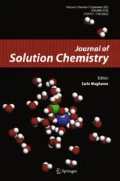Abstract
The salting-out effect has been characterized on the basis of the relative peak intensity of silica species, observed by FAB-MS (fast atom-bombardment mass spectrometry) in solutions of sodium chloride, sodium nitrate, sodium sulfate, calcium chloride, lithium chloride and magnesium chloride. A critical change in the peak intensity ratios of the linear and cyclic tetramers of silica against the sodium ion (Na+) concentrations was observed at Na+ concentration between 0.1 and 1 mol⋅dm−3. The degrees of the changes of these peak intensity ratios increased in the order NaNO3 < Na2SO4 < NaCl. In CaCl2 solutions, these peak intensity ratios changed significantly at Ca2+ concentrations between 0.05 and 0.5 mol⋅dm−3. The salting-out effect observed is the total change in the concentration of silica brought about by complex factors, such as the changing solubility of silicate complexes, the increases in the concentrations of different kinds of soluble silicate complexes induced by changes in the hydrophobicity and hydrophilicity of the solution, and the contribution of hydrolysis.
Similar content being viewed by others
References
1. Baes, C.F., Mesmer, R.E.: The Hydrolysis of Cations. John Wiley and Sons, New York (1976), pp. 336–342
2. Wijnen, P.W.J.G., Beelen, T.P.M., Dehaan, J.W., Van De Ven, L.J.M., Vansanten, R.A.: The structure direct effect of cations in aqueous silicate solutions. A 29Si-NMR study. Colloid Surface 45, 255–268 (1990)
3. Harris, R.K., Knight, C.T.: Silicon-29 nuclear magnetic resonance studies of aqueous silicate solutions. Part 5. J. Chem. Soc., Faraday Trans. 2 79, 1525–1538 (1983)
4. Harris, R.K., Kight, C.T.: Silicon-29 nuclear magnetic resonance studies of aqueous silicate solutions. Part 6. J. Chem. Soc., Faraday Trans. 2 79, 1539–1561 (1983)
5. Dove, P.M., Nix, C.J.: The influence of alkaline earth cations, magnesium, calcium, and barium on the dissolution kinetics of quartz. Geochim. Cosmochim. Acta 61, 3329–3340 (1997)
6. Tanaka, M., Takahashi, K.: Characterization of silica dissolved with sodium chloride solution using fast atomic bombardment mass spectrometry. J. Mass Spectrom. 35, 853–859 (2000)
7. Tanaka, M., Takahashi, K.: The identification and characterization of silicate complexes in calcium chloride solution using FAB-MS. Anal. Chim. Acta 411(1–2), 109–119 (2000)
8. Tanaka, M., Takahashi, K.: Determination of the changes of the basic structures of silica species in dependence on the concentration of sodium chloride by FAB-MS. Fresenius' J. Anal. Chem. 368, 786–790 (2000)
9. Tanaka, M., Takahashi, K.: Main species of silica dissolved in calcium chloride solution and their chemical implications for silica species in sodium chloride solution. J. Trace Microprobe Tech. 19, 581–589 (2001)
10. Tanaka, M., Takahashi, K.: Characterization of salting-out effect for silicate complexes in sodium chloride and nitrate solutions using a FAB-MS. Anal. Sci. 17 (Supplement), i21–i23 (2001)
11. Tanaka, M., Takahashi, K.: The identification of chemical species of silica in sodium hydroxide, potassium hydroxide and sodium chloride solutions by FAB-MS. Anal. Sci. 15, 1241–1250 (1999)
12. Tanaka, M., Takahashi, K.: Characterization of silicate monomer with sodium, calcium and strontium but not with lithium and magnesium ions by FAB-MS. J. Mass Spectrom. 37, 623–630 (2002)
13. Tanaka, M., Takahashi, K.: Silicate species in high pH solution molybdate, whose silica concentration is determined by colorimetry. Anal. Chim. Acta 429, 117–123 (2001)
14. Pokrovsky, G.S., Schott, J.: Experiment study of the complexation of silicon and germanium with aqueous species: Implication for germanium and silicon transport and Ge/Si ratio in natural waters. Geochim. et Cosmochim. Acta 62, 3413–3428 (1998)
15. Tanaka, M., Takahashi, K.: Characterization of silicate complexes in aqueous sodium sulfate solution by FAB-MS. J. Solution Chem. 34, 617–630 (2005)
16. Trémillon, B.: Reaction in Solution. An Applied Analytical Approach. Translated by D. Inman, John Wiley and Sons, Chichester (1977), p. 184
17. Ohtaki, H., Tanaka M., Funabashi, S.: Chemistry of the Reaction in Solution. Japan Scientific Societies Press (1977), p. 27
18. Ohtaki, H., Tanaka M., Funabashi, S.: Chemistry of the Reaction in Solution. Japan Scientific Societies Press (1977), p. 107
19. Yamada S., Tanaka, M.: Softness of some metal ions. J. Inorg. Nucl. Chem. 37, 587–589 (1975)
20. Edwards, J.O.: Correlation of relative rates and equilibria with a double basicity scale. J. Am. Chem. Soc. 76, 1540–1547 (1954)
Author information
Authors and Affiliations
Corresponding author
Rights and permissions
About this article
Cite this article
Tanaka, M., Takahashi, K. Study on the Salting-out Effect using Silica Species by FAB-MS. J Solution Chem 36, 27–37 (2007). https://doi.org/10.1007/s10953-006-9101-6
Received:
Accepted:
Published:
Issue Date:
DOI: https://doi.org/10.1007/s10953-006-9101-6




